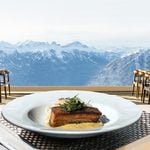This is How We Used the Kitchen Stove in the Great Depression

During the Great Depression, the old stove was the heart and soul of the kitchen—and family life.
I was born in rural Nova Scotia in the 1920s. Like many others, I have seen and enjoyed the changing times and advancements of our world, but I have also been thinking about things that were important to us back in the Great Depression era. One of those items was the old stove in the kitchen where I grew up.
The stove was wood-fired and placed near an inside wall of the kitchen with a woodbox nearby. It was black-topped, with a warming oven in the back and a water tank on the right side.
That stove had many uses. When Mother needed to iron clothes, she would put two or three “sad” irons (flat irons) on the stove to heat. There was always a fire in the stove, except in the warmest of weather. Mother had a wooden handle with a cast-iron base that would clip into the sad iron. As one iron would cool, she’d place it back on the stove and take a hot one. There was also always a kettle steaming on the stove to add moisture to our home; the kettle had an oyster shell inside to collect the mineral deposits from the water.
Every fall, we would peel and section apples, put them on strings and hang them behind the kitchen stove until dry. These would keep for months and be used to make delicious apple pies all winter.
My father also made homemade sauerkraut out of yellow turnips. He’d fill a big crock pot with turnips and layers of coarse salt. He would then wash a five-pound rock, place a big plate on top of the kraut, put the rock on top of it and place the whole thing behind the stove to cure. Speaking of behind the stove, in winter, when we came in from the cold, we’d place our mittens in the warming oven to dry. Sometimes, we would even crawl behind the stove ourselves to get some extra heat to warm up our bodies as well.
On our farm, when the Depression came, the car was put into the barn and horses were used for transportation instead. I used to accompany my Dad when he took grain to the Balmoral Grist Mill, which is now a museum, to be ground into flour, oatmeal or cattle feed. The kitchen stove would be used to cook the oatmeal all night in a double boiler to make delicious hot oatmeal for breakfast.
One year, Dad brought home the hulls from the grain. The hulls were put into a six- or seven-gallon crock pot that was filled with water and placed behind the stove. When the hulls were strained from the liquid, it was again placed behind the stove and left in the warm place until it turned into a gelatin-like substance. I remember they called it “zounds” and it was delicious served with cream and sugar.
I also remember my mother putting some kind of grains on cookie sheets and roasting these in the oven. They would make hot, coffee-like drinks in the cold weather.
Mother would also bake delicious biscuits and other goodies in the oven—with no thermometer, she gauged the temperature of the oven by putting her hand in it.
One winter, Dad made me a pair of skis. He took maple lumber, shaped the skis and put the front of them in the warm water in the tank at the end of the stove. I don’t remember how many hours or days he left them in the water, but later, he removed them and put them in some kind of mould to curve the front of the skis. He left them there to dry until they kept their shape.
One last vital task the old kitchen stove performed was our Saturday night bath. The big copper boiler was brought in and filled with water to heat, then the tub was brought into the kitchen and baths were enjoyed!
The kitchen stove—what a wonderful role it played in our lives. I suppose the only downside of it all was that growing up, I was the one who had to keep the woodbox filled!
Fancy another walk down memory lane? Here’s what laundry day was like in the 1930s.






